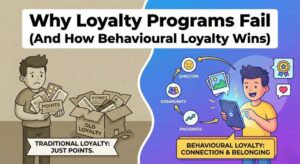Retention challenges don’t always look obvious. Some users don’t unsubscribe, complain, or close their accounts — they just quietly disengage.
These “silent drop-offs” can slip through the cracks, slowly eroding your customer base without sending clear churn signals.
In this blog, we explain what silent drop-offs are, how to spot them, and how brands can intervene early to improve retention.

What is a Silent Drop-Off?
A silent drop-off happens when a user disengages from your brand without explicitly opting out or unsubscribing.
They don’t complain or raise support tickets. They simply stop interacting — browsing less, engaging less, and eventually disappearing.
These users are dangerous to ignore because, on paper, they still look “active.” But they are no longer on a path to conversion, loyalty, or advocacy.
Common Silent Drop-Off Patterns to Watch
Silent drop-offs often don’t announce themselves. Instead, they show subtle shifts in behavior, such as:
- A gradual decline in visit or login frequency
- Shorter session times
- Fewer interactions with emails, push notifications, or offers
- Skipping key actions like adding to cart, completing purchases, or engaging with loyalty programs
These patterns can occur well before actual churn and offer a valuable early warning signal.
Behavioral Signals That Predict Future Churn
Spotting future churn requires looking beyond obvious metrics.
Some behavioral signals that hint a user is slipping away include:
- Browsing without transacting over multiple sessions
- Ignoring communications on their preferred channels
- Falling outside of their usual purchase or usage cadence (e.g., hasn’t logged in or purchased for a timeframe that used to be typical for them)
Data Sources to Identify Silent Drop-Offs
Silent drop-offs can’t be addressed unless you know where to look.
Useful data sources include:
- CRM activity history: last purchase date, last login
- Web and app analytics: session depth, bounce rates, path analysis
- Email and push metrics: open rates, click-through rates, ignored notifications
- Transaction history: declining average order value or frequency
Tactics to Re-Engage Before It’s Too Late
Once you spot a silent drop-off pattern, the next step is proactive intervention:
- Early re-engagement journeys: nudges triggered after reduced activity periods
- Personalized reminders: showcasing relevant products or content
- Incentives: exclusive offers to motivate return
- Value reinforcement: reminding users why they chose your brand in the first place
The key is to act before disengagement hardens into true churn.
MarTech Tools That Help Spot Silent Drop-Offs
Many modern marketing technology platforms help automate detection and intervention:
- Segmentation tools: define inactivity windows based on behavior
- Predictive churn models: score users for churn risk
- Automated triggers: send timely nudges when drop-off patterns emerge
At ConSoul, we help brands configure these tools properly so insights translate into action.
From Silent Signals to Proactive Retention
Silent drop-offs are a hidden source of churn risk — but they’re not invisible if you know where to look.
By monitoring subtle behavioral changes and acting early, brands can protect revenue, improve retention, and deliver a smoother customer experience.
Spotting churn too late costs more.
Spotting it early means you have a chance to win back loyalty, without excessive acquisition spend.
Need help identifying and recovering silent drop-offs in your business?
Contact ConSoul to learn how we design behavior-led retention programs tailored for your audience and MarTech stack.



